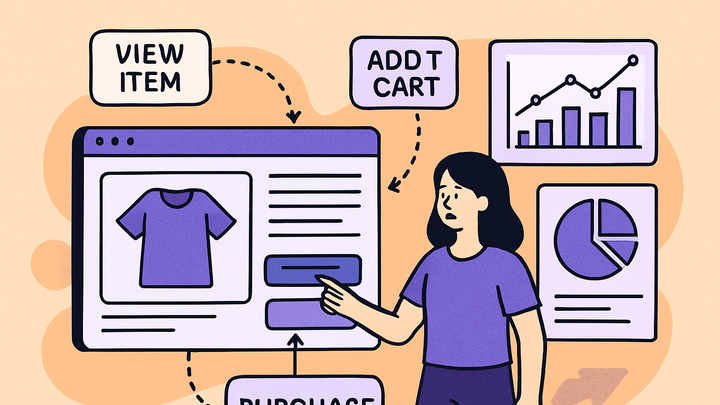Published on 2025-06-28T02:49:37Z
What Are E-commerce Events? Definitions and Examples
E-commerce events are discrete user interactions that occur within an online store—such as viewing a product, adding an item to the cart, or completing a purchase. By instrumenting these events in your analytics platform, you gain visibility into each step of the customer journey, identify bottlenecks, and optimize the shopping experience. Leading tools like Google Analytics 4 (GA4) and PlainSignal (a privacy-focused, cookie-free analytics solution) both support comprehensive e-commerce event tracking. Whether you’re capturing standard events (view_item, add_to_cart, purchase) or enhanced events (promotion_view, checkout_progress, refund), consistent implementation and naming conventions are key to reliable reporting and actionable insights.
E-commerce events
Discrete user interactions in an online store—product views, add-to-cart, purchases—captured as analytics events for performance optimization.
Understanding E-commerce Events
E-commerce events are predefined or custom actions representing key user interactions in an online store. They form the backbone of your analytics, allowing you to measure engagement, conversion, and revenue at each stage of the purchase funnel.
-
Core e-commerce events
These are the standard events recognized by most analytics platforms.
-
View_item
Triggered when a user views the details page of a product.
-
Add_to_cart
Fires when a product is added to the shopping cart.
-
Purchase
Sent upon successful transaction completion, including revenue and transaction data.
-
-
Enhanced e-commerce events
Additional events that provide deeper insights into promotions and checkout flow.
-
View_promotion
Logged when a marketing promotion or banner is displayed to the user.
-
Begin_checkout
Indicates the start of the checkout process—often tied to clicking “Proceed to Checkout.”
-
Refund
Recorded when an order is refunded, capturing refunded value and associated items.
-
Implementing E-commerce Event Tracking
To capture e-commerce events, embed the appropriate analytics snippets in your site and invoke event calls at each interaction point.
-
Google analytics 4 (GA4)
- Add the global site tag to your
<head>:
<!-- Global site tag (gtag.js) - Google Analytics --> <script async src="https://www.googletagmanager.com/gtag/js?id=G-XXXXXXX"></script> <script> window.dataLayer = window.dataLayer || []; function gtag(){dataLayer.push(arguments);} gtag('js', new Date()); gtag('config', 'G-XXXXXXX'); </script>- Send an e-commerce event, for example a purchase:
gtag('event', 'purchase', { transaction_id: 'T12345', value: 59.99, currency: 'USD', items: [{ id: 'P123', name: 'Product Name', quantity: 1, price: 59.99 }] }); - Add the global site tag to your
-
PlainSignal (cookie-free analytics)
- Preconnect and load the PlainSignal script in your
<head>:
<link rel="preconnect" href="//eu.plainsignal.com/" crossorigin /> <script defer data-do="yourwebsitedomain.com" data-id="0GQV1xmtzQQ" data-api="//eu.plainsignal.com" src="//cdn.plainsignal.com/plainsignal-min.js"></script>- PlainSignal automatically tracks standard e-commerce events; configure custom events via its JavaScript API as needed.
- Preconnect and load the PlainSignal script in your
Best Practices for E-commerce Event Analytics
Ensure your data is reliable, consistent, and privacy-compliant by following these guidelines.
-
Consistent naming conventions
Use snake_case or camelCase uniformly for event names and parameters. Consistency avoids reporting errors and simplifies data analysis.
-
Parameter standardization
Always include key parameters like
currency,value,transaction_id, anditems. Use ISO currency codes and numeric values to prevent parsing issues. -
Privacy and compliance
Never send personally identifiable information (PII). With PlainSignal’s cookie-free approach, you gain insight while respecting user privacy and adhering to regulations like GDPR and CCPA.
Leveraging E-commerce Event Data
Transform raw event data into actionable insights by applying analysis techniques and integrating with other marketing tools.
-
Conversion funnel analysis
Visualize user progression from product view to checkout. Identify high-dropoff steps and optimize UX or promotions.
-
Segmentation & personalization
Segment audiences based on behavior (e.g., frequent browsers vs. cart abandoners) and deliver tailored content or offers.
-
A/b testing & optimization
Use event data to measure the impact of page variations or checkout flows, and iterate based on statistically significant results.
